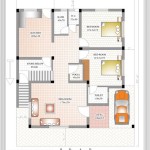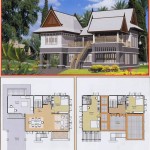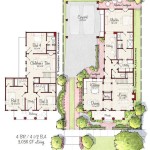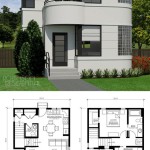Detached House Plans: A Comprehensive Guide
Detached house plans represent a cornerstone of residential architecture, offering homeowners a unique sense of privacy and independence. This housing style, characterized by a single-family dwelling that does not share walls with any other building, remains a popular choice for individuals and families seeking autonomy and space. The selection and implementation of detached house plans involve numerous considerations, ranging from architectural style and lot size to interior layout and cost implications. This article provides a comprehensive overview of detached house plans, exploring various aspects vital to informed decision-making.
The process of choosing the right detached house plan typically begins with defining specific needs and preferences. Factors such as family size, lifestyle, budget, and desired aesthetic play significant roles in narrowing down the options. Understanding local building codes and zoning regulations is also crucial, as these dictate permissible building heights, setbacks, and other crucial parameters that must be adhered to during construction.
Key Considerations in Detached House Plan Selection
Several key considerations guide the selection process for detached house plans. These encompass the architectural style, the size and layout of the house, and the overall functionality and aesthetic appeal. Failing to adequately address these factors can lead to dissatisfaction with the final product or even costly revisions during the construction phase.
Architectural style significantly influences the overall look and feel of the house. Popular styles for detached houses include traditional designs like Colonial, Victorian, and Craftsman, as well as contemporary styles such as Modern, Ranch, and Contemporary. Each style has distinct characteristics that appeal to different tastes. Colonial houses, for instance, typically feature symmetrical facades, gabled roofs, and evenly spaced windows. Craftsman homes, on the other hand, often showcase low-pitched roofs, exposed rafters, and wide porches. Modern designs prioritize clean lines, open floor plans, and large windows that maximize natural light. The choice of architectural style should align with the homeowner's aesthetic preferences and the character of the surrounding neighborhood.
The size and layout of the house should correspond to the needs of the occupants. Considerations include the number of bedrooms and bathrooms, the size of the living areas, and the presence of specialized spaces such as home offices, game rooms, or workshops. Open floor plans, which combine living, dining, and kitchen areas, are popular for their spaciousness and flexibility. However, some homeowners prefer more defined spaces for added privacy and separation. It is important to carefully consider the flow of traffic within the house and to ensure that the layout is both functional and comfortable.
Furthermore, the exterior design of the house should complement the surrounding landscape and reflect the homeowner's individual style. Features such as porches, decks, patios, and landscaping can enhance the curb appeal of the house and provide outdoor living spaces. The choice of exterior materials, such as siding, brick, stone, and roofing, can also impact the overall aesthetic and durability of the house.
Understanding Different Types of Detached House Plans
Detached house plans come in a variety of configurations, each suited to different needs and preferences. Popular categories include single-story plans, two-story plans, split-level plans, and custom-designed plans. Each type offers distinct advantages and disadvantages that should be carefully evaluated.
Single-story plans, also known as ranch houses, offer the advantage of easy accessibility, as all living spaces are located on a single level. This is particularly beneficial for individuals with mobility issues or those who prefer to avoid stairs. Single-story houses also tend to be easier and less expensive to build, as they require less foundation work and structural support. However, single-story plans generally require a larger lot size to accommodate the desired square footage.
Two-story plans provide more living space on a smaller footprint, as the square footage is distributed over two levels. This makes them a good choice for homeowners with limited lot space. Two-story houses also offer better privacy, as the bedrooms are typically located on the upper level, away from the main living areas. However, two-story plans require stairs, which may pose challenges for some individuals. They can also be more expensive to build than single-story houses due to the increased structural complexity.
Split-level plans feature multiple levels connected by short flights of stairs. This design is well-suited for sloping sites, as it allows the house to conform to the natural topography of the land. Split-level houses offer a unique layout with distinct zones for living, sleeping, and recreation. However, the multiple levels and short staircases can make them less accessible than single-story or two-story houses.
Custom-designed plans offer the ultimate in personalization, allowing homeowners to create a house that perfectly fits their needs and preferences. A custom design involves working with an architect or designer to develop a unique plan that incorporates specific features, layouts, and architectural styles. While custom designs can be more expensive and time-consuming than stock plans, they offer the opportunity to create a truly one-of-a-kind home.
Cost Considerations and Budgeting for Detached House Plans
The cost of building a detached house can vary significantly depending on several factors, including the size of the house, the complexity of the design, the quality of materials, and the location of the project. Developing a realistic budget is essential to ensure that the project remains financially feasible throughout the construction process.
The first step in budgeting for a detached house plan is to obtain accurate cost estimates from builders and contractors. It is advisable to obtain multiple bids from different contractors to ensure that the pricing is competitive. The cost estimates should include all aspects of the project, including materials, labor, permits, and fees. It is also important to factor in contingency funds to cover unexpected expenses or changes that may arise during construction.
The cost of materials can significantly impact the overall budget. High-end finishes, such as granite countertops, hardwood floors, and custom cabinetry, can add considerable expense. Selecting more affordable alternatives, such as laminate countertops, vinyl flooring, and stock cabinets, can help to reduce costs without sacrificing functionality. It is also important to research the cost of lumber, roofing, siding, and other essential building materials.
Labor costs typically account for a significant portion of the construction budget. The rates charged by contractors, subcontractors, and other tradespeople can vary depending on their experience, expertise, and location. It is essential to hire qualified and experienced professionals to ensure that the work is completed to a high standard. Cutting corners on labor costs can lead to poor workmanship and costly repairs in the future.
Permit fees and other regulatory costs can also contribute to the overall budget. These fees are typically charged by local municipalities to cover the costs of inspections, reviews, and other administrative processes. The amount of these fees can vary depending on the size and complexity of the project.
Beyond the initial construction costs, it's important to consider ongoing expenses associated with owning a detached house, such as property taxes, insurance, and maintenance. These costs should be factored into the long-term financial planning for the house.
Furthermore, consider the energy efficiency of the house plan. Incorporating energy-efficient features, such as high-performance windows, insulation, and appliances, can reduce utility bills and contribute to a more sustainable lifestyle. While these features may add to the initial construction costs, they can provide significant savings over the long term.
Figure A 2 Single Detached House Floor Plans 61 Scientific Diagram

Floor Plan Of A Typical Single Family Detached House Scientific Diagram

House Design Semi Detached Plan Ch121d 20 Layout Plans Duplex Bungalow Floor

Versatile Semi Detached Home Plan 22374dr Architectural Designs House Plans

House Design Semi Detached Plan Ch118d 20 Duplex Plans Building Designs

Two Y Detached House Plan The Eastnor Houseplansdirect

Semi Detached House Plans And Duplex Drummond

4 Bedroom Semi Detached Duplex Cs 4801 N House Plans

Semi Detached One Gnet 3d

Duplex House Ch120d Plan For Two Families








